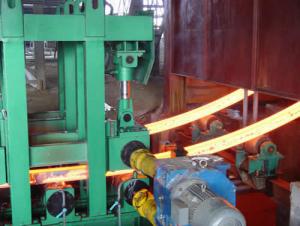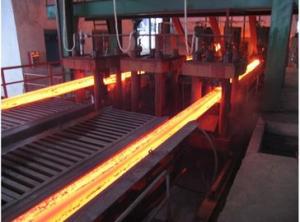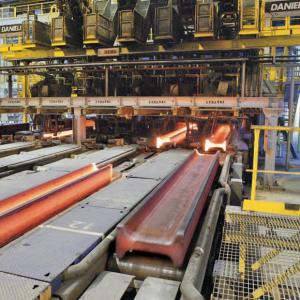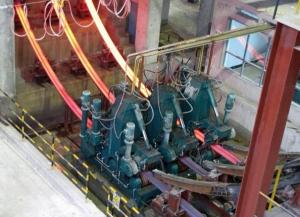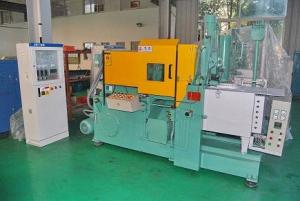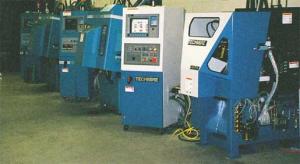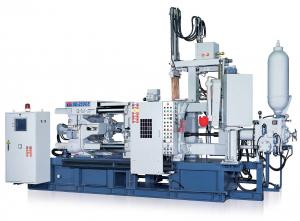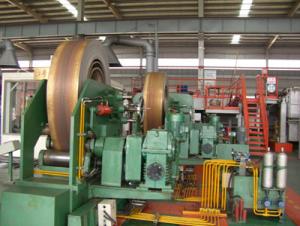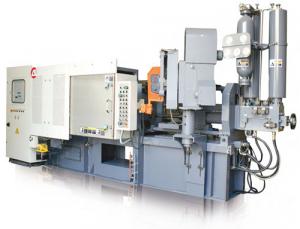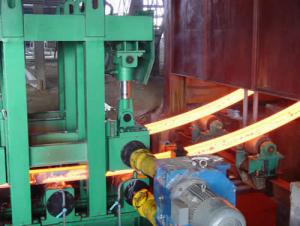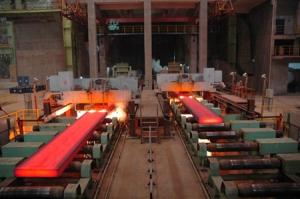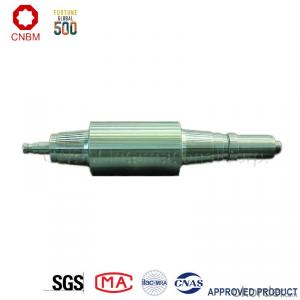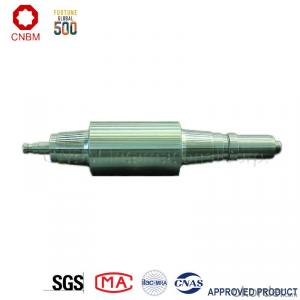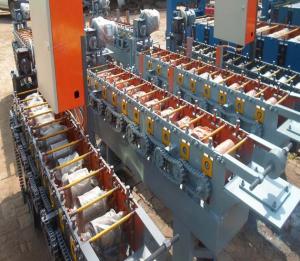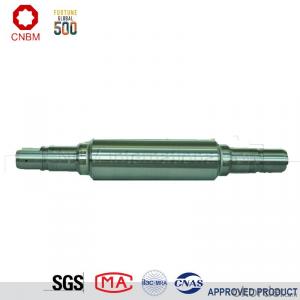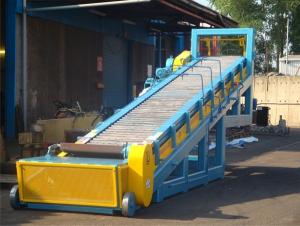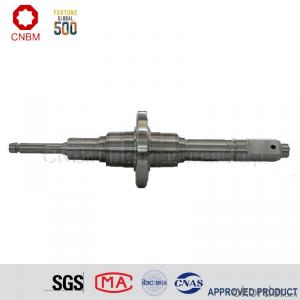Continuous Casting Machine
- Loading Port:
- China Main Port
- Payment Terms:
- TT or LC
- Min Order Qty:
- 1 Set set
- Supply Capability:
- 30 Sets Per Year set/month
OKorder Service Pledge
Quality Product, Order Online Tracking, Timely Delivery
OKorder Financial Service
Credit Rating, Credit Services, Credit Purchasing
You Might Also Like
Technology process:
1.Heat the EVA film
2.Cover the heated EVA film on the mould(can be made from wood or aluminum)
3.Spray a coating in a certain baume degree
4.Put on the empty blask
5.Sand-up the flask and vibrate to compaction
Packaging & Delivery
Packaging Details:containers
Delivery Detail:Complete one set of equipment needs for three months
- Q: What are the different types of binders used in sand casting with metal casting machinery?
- There are several types of binders used in sand casting with metal casting machinery, including clay binders, resin binders, and water-based binders. Clay binders, such as bentonite, are commonly used as they provide good strength and permeability to the sand mixture. Resin binders, such as phenolic or urethane resins, are used to improve the strength and dimensional accuracy of the mold. Water-based binders, like colloidal silica, are used for their environmental friendliness and ease of removal after casting.
- Q: How can defects be prevented or minimized in lost foam casting with metal casting machinery?
- Defects in lost foam casting with metal casting machinery can be prevented or minimized through various measures. Firstly, ensuring the foam pattern used is of high quality and free from any imperfections or deformities is crucial. This can be achieved by using precision molds and controlling the foam production process effectively. Additionally, proper gating and risering systems should be designed to ensure smooth and consistent metal flow during casting. This helps in avoiding defects like misruns or cold shuts. Proper venting of the mold is also essential to prevent gas-related defects such as porosity. Controlling the pouring temperature and metal composition is another important factor to consider. Maintaining the correct pouring temperature helps in avoiding defects like shrinkage or distortion in the final casting. The metal composition should also be carefully monitored to prevent any chemical imbalances that could lead to defects. Furthermore, implementing rigorous quality control measures throughout the entire casting process, including inspections and testing, can help identify and rectify any defects before they become significant issues. Regular maintenance and calibration of the casting machinery also play a vital role in preventing defects and ensuring consistent and high-quality castings.
- Q: What are the different types of maintenance and repair services available for metal casting machinery?
- There are several different types of maintenance and repair services available for metal casting machinery. These services are essential for ensuring the optimal functioning and longevity of the machinery. Some of the most common types of maintenance and repair services for metal casting machinery include: 1. Routine maintenance: This involves regular inspection and maintenance tasks such as lubrication, cleaning, and checking for any signs of wear and tear. Routine maintenance helps to prevent major breakdowns and ensures the smooth operation of the machinery. 2. Preventive maintenance: Similar to routine maintenance, preventive maintenance involves planned inspections and maintenance activities to prevent potential issues. This includes replacing worn-out parts, adjusting components, and conducting tests to identify any potential problems before they occur. 3. Emergency repairs: In cases where unexpected breakdowns or malfunctions occur, emergency repair services are essential. These services involve diagnosing the issue, repairing or replacing faulty parts, and getting the machinery back up and running as quickly as possible. 4. Component repair or replacement: Over time, certain components of metal casting machinery may wear out or become damaged. In such cases, specific components such as pumps, valves, bearings, or motors may need to be repaired or replaced. This helps to maintain the efficiency and functionality of the machinery. 5. Upgrades and modifications: As technology advances, it may be necessary to upgrade or modify existing metal casting machinery to improve its performance or meet changing requirements. Upgrades and modifications can include installing new control systems, integrating automation, or enhancing safety features. 6. Calibration and alignment: Metal casting machinery requires precise calibration and alignment to ensure accurate and consistent results. Calibration services involve adjusting and fine-tuning the machinery to meet specific standards and specifications. Alignment services ensure that all components are properly aligned and positioned for optimal performance. 7. Training and support: In addition to maintenance and repair services, many providers offer training and support services to help operators and maintenance personnel understand and operate the machinery effectively. This includes training on safety procedures, troubleshooting techniques, and preventive maintenance practices. Overall, the different types of maintenance and repair services available for metal casting machinery aim to ensure its reliability, efficiency, and longevity. Regular maintenance and timely repairs are crucial for minimizing downtime, maximizing productivity, and prolonging the lifespan of the machinery.
- Q: What are the maintenance costs associated with metal casting machinery?
- The maintenance costs associated with metal casting machinery can vary depending on several factors. Firstly, regular maintenance tasks such as lubricating moving parts, replacing worn-out components, and cleaning the machinery are essential to ensure optimal performance. These routine maintenance activities help prevent breakdowns, reduce the risk of accidents, and extend the lifespan of the machinery. The costs for these tasks typically include the purchase of lubricants, replacement parts, and cleaning supplies. Additionally, metal casting machinery may require occasional major repairs or overhauls. These can be more expensive and may involve hiring specialized technicians or purchasing specific tools and equipment. The costs for major repairs can vary significantly depending on the complexity of the machinery and the extent of the damage. Furthermore, metal casting machinery often requires regular calibration and adjustments to maintain accuracy and precision. This may involve hiring skilled technicians or using specialized measuring instruments and tools. The costs for calibration and adjustment can vary depending on the frequency required and the complexity of the machinery. Another aspect to consider is the cost of downtime during maintenance activities. When metal casting machinery is undergoing maintenance, it is not operational, resulting in a loss of production. This can impact the overall productivity and profitability of the casting process. Therefore, it is important to factor in the potential revenue loss when calculating the maintenance costs. Lastly, training and education for operators and maintenance personnel should be considered. Providing training on proper machine operation, maintenance procedures, and safety protocols can help minimize the risk of accidents and reduce the likelihood of costly mistakes or equipment damage. In conclusion, the maintenance costs associated with metal casting machinery encompass routine maintenance tasks, major repairs, calibration and adjustments, potential revenue loss due to downtime, and training expenses. These costs can vary depending on the complexity of the machinery, the frequency of maintenance required, and the level of expertise needed for repairs and calibration.
- Q: What are the considerations for air pollution prevention and control in metal casting machinery?
- Metal casting machinery requires several important considerations for preventing and controlling air pollution. The first and foremost consideration is the implementation of effective engineering controls within the machinery itself. This entails installing efficient capture and ventilation systems that can effectively capture and remove airborne pollutants generated during the casting process. By designing and maintaining these systems properly, the release of pollutants into the air can be minimized. Another consideration involves the use of appropriate materials and technologies during the casting process. For example, utilizing cleaner fuels and reducing the use of hazardous chemicals can greatly reduce air pollution. Furthermore, the adoption of advanced technologies like low-emission burners or filtration systems can aid in controlling and reducing air pollutants emitted during casting. Regular maintenance and inspection of the machinery are vital considerations as well. Ensuring proper maintenance and optimal functionality of the machinery can help minimize emissions and prevent potential leaks or malfunctions that may contribute to air pollution. In addition, it is crucial to establish comprehensive training and education programs for workers involved in metal casting. By educating them about the importance of preventing and controlling air pollution and providing them with the necessary knowledge and skills for safe and efficient machinery operation, the risk of air pollution can be significantly reduced. Compliance with environmental regulations and standards is another critical consideration. Industries involved in metal casting must adhere to local, national, and international regulations related to air pollution control. This may include obtaining permits, conducting regular emissions testing, and implementing proper monitoring and reporting systems. Finally, fostering a culture of environmental responsibility within the organization is essential. Encouraging active employee participation in pollution prevention and control efforts, promoting sustainability, and continually seeking innovative solutions can make a significant contribution to reducing air pollution in metal casting machinery.
- Q: What are the cost-saving measures for metal casting machinery?
- There are numerous ways to achieve cost savings in metal casting machinery. Here are some effective strategies: 1. Efficient energy utilization: Energy consumption is a significant expense in metal casting machinery. To save costs, it is crucial to ensure the machinery operates efficiently and employs energy-saving techniques. This includes using energy-efficient motors and implementing proper insulation. 2. Process enhancement: Analyzing the metal casting process is essential for cost savings. Identifying areas that require improvement, such as optimizing casting cycle time, reducing material waste, and minimizing rework or scrap, can result in substantial savings in both material and labor costs. 3. Regular maintenance and equipment upgrades: Regular maintenance is vital to prevent breakdowns and minimize downtime. By investing in preventive maintenance, manufacturers can avoid costly repairs and prolong the machinery's lifespan. Additionally, upgrading outdated equipment with newer, more efficient models can reduce operating costs and enhance productivity. 4. Automation and robotics: The integration of automation and robotics can reduce labor costs and improve efficiency in metal casting processes. Automated systems can perform repetitive tasks accurately and quickly, minimizing the need for manual labor and reducing the risk of human errors. Investing in robotic solutions can lead to significant long-term cost savings. 5. Material selection and recycling: Careful selection of materials for metal casting can have a substantial impact on cost savings. Opting for lower-cost alloys or utilizing recycled materials can reduce raw material expenses without compromising quality. Furthermore, implementing recycling programs for scrap metal generated during the casting process can provide additional cost-saving opportunities. 6. Effective supply chain management: Efficient supply chain management is crucial for cost savings in metal casting machinery. Negotiating favorable contracts with suppliers, optimizing inventory levels, and minimizing transportation costs can all contribute to reducing overall production expenses. By implementing these cost-saving strategies, manufacturers can optimize their metal casting machinery operations, decrease expenses, and enhance long-term profitability.
- Q: Can metal casting machinery be used for producing castings with good surface hardness?
- Yes, metal casting machinery can be used for producing castings with good surface hardness. The surface hardness of a casting is typically determined by the type of metal used, the casting process, and the heat treatment applied. Metal casting machinery, such as foundry furnaces, molds, and core-making equipment, can be designed to accommodate various types of metals with different hardness properties. By carefully selecting the appropriate metal alloy and controlling the casting process parameters, it is possible to achieve castings with good surface hardness. Furthermore, heat treatment processes can be employed after the casting is solidified to enhance the surface hardness. Heat treatment techniques like quenching, tempering, and case hardening can be utilized to transform the microstructure of the casting, resulting in improved surface hardness. However, it is important to note that achieving good surface hardness in castings also requires proper design and quality control measures. Factors such as the design of the casting, the quality of the mold, and the cleanliness of the metal all play a crucial role in determining the surface hardness. In summary, while metal casting machinery can be used for producing castings with good surface hardness, it is a multifaceted process that involves the careful selection of metal alloys, controlling the casting process, and applying appropriate heat treatment techniques.
- Q: How can defects be minimized or eliminated in metal casting machinery?
- Defects in metal casting machinery can be minimized or eliminated by implementing several measures. Firstly, maintaining the machinery and regularly inspecting it for any wear and tear is crucial. This includes checking for any damaged or worn-out parts and promptly replacing them. Secondly, optimizing the casting process parameters such as temperature, pressure, and cooling rates can significantly reduce defects. Additionally, utilizing advanced technology like computer simulations and 3D modeling helps in identifying potential defects and optimizing the design of the mold. Lastly, implementing stringent quality control measures, including thorough inspections and testing of the final products, ensures that any defects are detected and eliminated before they reach the market.
- Q: Is there a limit to the size of castings that metal casting machinery can produce?
- Yes, there is a limit to the size of castings that metal casting machinery can produce. The size of castings that can be produced is determined by the capacity and capabilities of the specific casting machine being used. Larger castings require larger and more powerful machinery to handle the increased size and weight.
- Q: How does metal casting machinery handle the removal of distortion and warping from the castings?
- Metal casting machinery typically handles the removal of distortion and warping from castings through a combination of processes and techniques. One common method is heat treatment, which involves subjecting the castings to controlled heating and cooling cycles to relieve internal stresses and restore their original shape. This process helps to minimize distortion and warping caused by uneven cooling rates during solidification. Another technique used is called straightening, where the castings are mechanically manipulated to correct any misalignments or deformations. This is often done by applying pressure or force to specific areas of the casting to bring it back to its intended shape. Straightening can be done manually using tools such as hammers or hydraulic presses, or it can be automated using specialized machinery designed for this purpose. In addition to heat treatment and straightening, metal casting machinery may also employ various machining and finishing processes to further refine the castings and eliminate any remaining distortion or warping. This can involve using CNC milling, grinding, or lathing techniques to remove excess material or reshape specific areas of the casting. Overall, the goal of metal casting machinery is to produce castings that meet the required dimensional and geometrical specifications. By carefully controlling the casting process and employing techniques such as heat treatment, straightening, and machining, manufacturers can effectively handle the removal of distortion and warping from castings, ensuring high-quality finished products.
Our professions include metallurgical technology, equipment and automation. We can provide the best solutions to the production process, design & manufacture of equipment and electrical automation regarding various industries in domestic and foreign districts with exquisite technology and fine quality service. We can provide all-around services to customers from development & design to the provision, installation and running of products.Strong technical strength, advanced equipment manufacturing technology, fine quality professional talents, and perfect service systems all bring about reliability, relaxation, convenience and delight to the cooperation with customers from beginning to end.
1. Manufacturer Overview
| Location | Jiangsu,China (Mainland) |
| Year Established | 2000 |
| Annual Output Value | |
| Main Markets | South America Eastern Europe Southeast Asia Africa Mid East South Asia Domestic Market |
| Company Certifications |
2. Manufacturer Certificates
| a) Certification Name | |
| Range | |
| Reference | |
| Validity Period |
3. Manufacturer Capability
| a) Trade Capacity | |
| Nearest Port | SHANGHAI |
| Export Percentage | 21% - 30% |
| No.of Employees in Trade Department | 3-5 People |
| Language Spoken: | English, Chinese |
| b) Factory Information | |
| Factory Size: | |
| No. of Production Lines | |
| Contract Manufacturing | |
| Product Price Range | |
Send your message to us
Continuous Casting Machine
- Loading Port:
- China Main Port
- Payment Terms:
- TT or LC
- Min Order Qty:
- 1 Set set
- Supply Capability:
- 30 Sets Per Year set/month
OKorder Service Pledge
Quality Product, Order Online Tracking, Timely Delivery
OKorder Financial Service
Credit Rating, Credit Services, Credit Purchasing
Similar products
Hot products
Hot Searches
